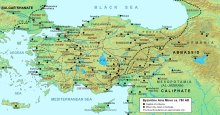Thrace (theme)
| Theme of Thrace θέμα Θρᾴκης, θέμα Θρᾳκῷον | |
|---|---|
| Themeof theByzantine Empire | |
| c. 680–1204 1230s–14th century | |
 The Byzantinethemataof Asia Minor and thethemaof Thrace in c. 780. | |
| Capital | Constantinople(Istanbul) /Adrianople(Edirne)/Arcadiopolis(Lüleburgaz) |
| Historical era | Middle Ages |
• Established | 680/681 |
•Latinconquest | 1204 |
•Nicaeanrecovery | 1230s |
• Divided into smaller units. | 14th century |
| Today part of | Turkey |
TheTheme of Thrace(Greek:θέμα Θρᾴκης or θέμα Θρᾳκῷον) was a province (themaortheme) of theByzantine Empirelocated in the south-easternBalkans,comprising varying parts of theeponymous geographic regionduring its history.
History
[edit]Traditionally, it has been held that the theme (at the time primarily a military command) was constituted in c. 680, as a response to theBulgarthreat.[1][2][3]This is based on the mention of a certainpatrikiosTheodore, Count of theOpsikionandhypostrategosof Thrace, in 680/681. However, it is unclear whether this implies the existence of Thrace as a separate command, with Theodore holding a dual post, or whether Thrace was administratively united to theOpsikion.In fact, separatestrategoiof Thrace are not clearly attested in literary sources until 742, while seals ofstrategoiare also extant only from the eighth century on.[3][4]Initially,Adrianoplewas probably the theme's capital.
Under EmpressIrene of Athens,in the late eighth century, the theme was divided, with the western part being constituted as the separate theme ofMacedonia.From then on, the theme's capital was atArcadiopolis,with subordinatetourmarchaiatBizyeandSozopolis.Another, calledtourmarches tes Thrakes( "of Thrace" ) is also attested, possibly thestrategos'deputy at Arcadiopolis.[2]TheArabgeographersIbn Khordadbeh(wrote ca. 847) andIbn al-Faqih(wrote ca. 903) mention the theme as extending "from the long wall [theAnastasian Wall] "to the theme of Macedonia, and north up to the country of theBulgars,counting 10 fortified places and 5,000 troops.[5]Indeed, the boundaries of the theme fluctuated along with the northern frontier of Byzantium during theByzantine–Bulgarian Wars.Initially, the theme must have comprised most of the ancientDiocese of Thrace,except for the country along theDanubeoverrun by the Bulgars (Lower Moesia), but after the conquests ofKrum(r. 803–814),Omurtag(r. 814–831), andSymeon(r. 893–927) the border moved by stages south of theBalkan mountainsto roughly the line of the present Bulgarian frontier withGreeceandTurkey.Thus, at around the start of the tenth century, the theme comprised essentially the eastern half of modernEastern Thrace,although it extended north along the coast to includeAnchialos.[6]
From the eleventh century, Thrace and Macedonia appear to have been usually combined, as attested by numerousstrategoiand judges (kritai) holding jurisdiction over both themes.[2][7]The name fell out of use as an administrative term in thePalaiologan period,but it is still encountered in some historians of the time as an antiquarian term.[7]
References
[edit]- ^Haldon 1997,p. 216.
- ^abcNesbitt & Oikonomides 1991,p. 155.
- ^abPertusi 1952,p. 156.
- ^Kazhdan 1991,pp. 2079–2080.
- ^Pertusi 1952,p. 157.
- ^Pertusi 1952,pp. 157–158.
- ^abKazhdan 1991,p. 2080.
Sources
[edit]- Haldon, John F. (1997).Byzantium in the Seventh Century: The Transformation of a Culture.Cambridge: Cambridge University Press.ISBN978-0-521-31917-1.
- Kazhdan, Alexander,ed. (1991).The Oxford Dictionary of Byzantium.Oxford and New York: Oxford University Press.ISBN0-19-504652-8.
- Nesbitt, John;Oikonomides, Nicolas,eds. (1991).Catalogue of Byzantine Seals at Dumbarton Oaks and in the Fogg Museum of Art, Volume 1: Italy, North of the Balkans, North of the Black Sea.Washington, DC: Dumbarton Oaks Research Library and Collection.ISBN0-88402-194-7.
- Pertusi, A. (1952).Constantino Porfirogenito: De Thematibus(in Italian). Rome: Biblioteca Apostolica Vaticana.
Further reading
[edit]- Humphreys, Mike (2018)."Thrace, Theme of".In Nicholson, Oliver (ed.).The Oxford Dictionary of Late Antiquity.Oxford: Oxford University Press.ISBN978-0-19-866277-8.
